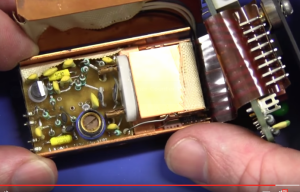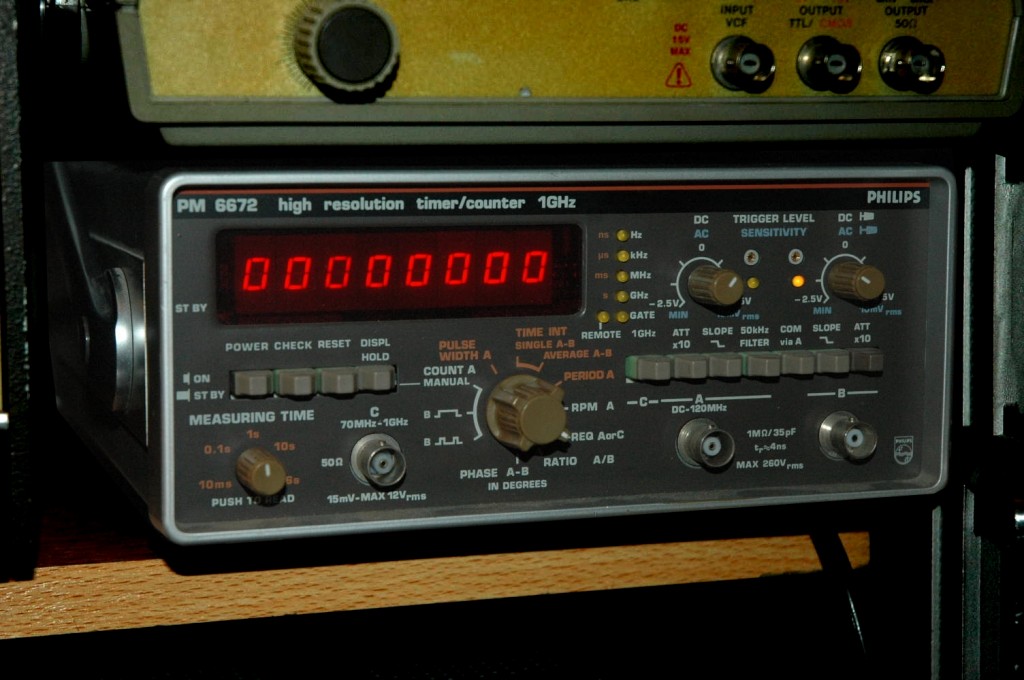This 8 digit Philips counter has some functions you do not often find on counters. It is equipped with a temperature controlled oven for the 10MHz reference oscillator. Besides that it has an input for an external 10 MHz timestandard.
There are many options like a battery-pack, ovens, BCD output, analog recorder output, ICE625 / IEEE488 Interface, and an external reference frequency multiplier. Besides that they sold adapters, cables, in line terminators and probesets. A counter can not be equiped with all options at the same time. Some need each-other and then there is the space inside problem. It is a small cabinet.
Be careful if yours has the batteries. They can leak and kill your counter. The risk is not high because the batteries are on the bottom of the cabinet and under the main pcb.
There are 5 versions regarding the timebase stability. The simplest one, option /01 is just a standard xtal. Option /02 PM9678 has a tcxo. (A temperature compensated Xtal oscillator). Option /03 PM9679, /04 PM9690 and /05, PM9691 , have a timebase with an oven. 05 is the most stable. Longtime 7,5x10E8. Option 01 is 5x10E6. Mine has option 05. When I got it from a friend who did not used it anymore, I think around 2009, I had no clue about how good it was. Later when I had a GPS based timestandard it turned out to be still spot-on.
The PM6672 measures upto 1GHz. This range is a separate prescaler pcb mounted under the main pcb. There are 3 models that are made on the same base. The PM6670, PM6671 and PM6672.
It is an input signal synchonized high resolution computing measuring method counter, in short, this is named reciprocal.
It has a few modes. CW, the normal frequency measure mode. Single burst and multiple burst frequency average, The latter measures during 10ms upto 96 secondes triggered by the external gate control and then computes the avarage. The switches to choose the mode are on the rear-panel.
As said, it has many functions. That makes it sometimes a bit hard to operate. the advantage is that you can measure signals many counters can not handle.
– Period average, 100ns upto 100s
– Time interval A to B single event, 100ns upto 10E8 seconds.
– Pulse width A, start/stop triggering on channel A
– Time interval A to B average
– Count A, range 1 to 10E17. Above 10E8 it shows Mega or Giga pulses.
– Phase A-B in degrees
– Ratio A to B, 0-10MHz per channel.
– RPM, the reading is in rounds per minute. 0.6 upto 10E8 rmp.
It has several channels as Philips named them, although that is not the way many will people think. The channels are not equal. A is the main input. It is high impedance and goes upto 120MHz. B is the channel A needs for some modes. C is the 50 ohm prescaler. It does 70 to 1000MHz. It is very sensitive. D is the external 10 MHz reference input or used as a 10MHz output. Channel E is used for external arming, averaging and reset. Besides that it has a gate monitor output. There is also a ext batt input to connect it to a 11.8-28VDC powwersupply.
It has a hold-off setting. This ignores a retrigger signal during the time set by the user. The check button is used to display the hold-of. Besides that, check has more functions like reading the external frequency, used as a stopwatch and for some selftests.
It has many adjustment controls on the front. The potentiometers have double functions. It is easy to get lost while operating it. Filters, trigger attenuator, coupling modes, AC or DC trigger level, display hold/reset, measure-time, hold-off, slope, com via A, senitivity and prescaler on. While measuring a gate led shows it is busy.


